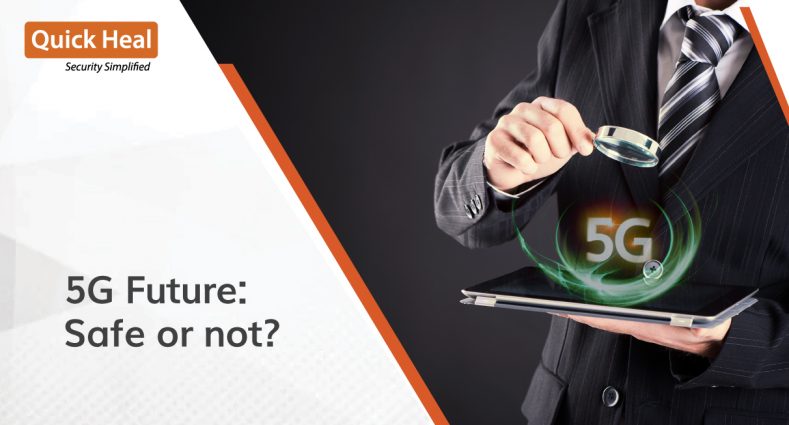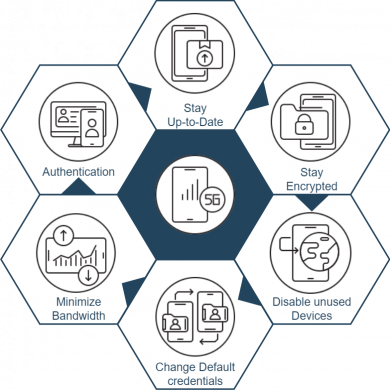Is the shift to 5G threatening the world of IoT Security?

The future is completely open, and so is IoT. The IoT or Internet of Things has completely digitized the way we work or perform daily routines. We not only use the IoT for entertainment but also to keep track of our fitness and workout routines. Even our homes are becoming more intelligent and innovative, and 5G wireless technology is touted as the “next generation” wireless network. While 5G wireless technology provides a much faster way to connect IoT devices, it also introduces new security issues. This blog discusses 5G vulnerabilities with IoT devices and how improved cybersecurity is essential to ensure a safe 5G future.
What is 5G? What are its features?
The fifth generation of wireless networks (5G networks) is designed to connect virtually everything to machine learning, the internet of things (IoT), and other IoT technology. It’s also called wifi-LTE, and it is much faster than 4G. 5G brings many new features such as:
- Reduced latency: Delivering latency as low as 1ms
- Connection Density: Enabling 10x more efficient connectivity for IoT devices
- Throughput: Bringing uniform multi-Gbps peak rates
- Lower power consumption: Making network processes more efficient to optimize the energy usage
- Higher capacity: Driving network hyper-densification with more cells everywhere
5G capabilities
- Sensor technology is built into new machinery to monitor its vital systems enabling us to stop and start other potential problems before they occur.
- Increasing yields in agriculture, tackling pollution, and working more efficiently are ways IoT can be used on farms.
- Vehicular automation systems exchange data across vehicles to avoid road collisions.
- The most successful IoT product will be in the form of a seamless combination of sensors that would detect natural disasters and can warn users before the disaster occurs.
- 5 G-enabled drones are becoming a key tool to add an extra layer of support for emergency response.
Internet of Things (IoT)
The Internet of Things (IoT) describes a growing ensemble of sensors, physical objects, and the technology embedded within them that enables these objects to interact with one another via the internet. This area has high expectations, with no less than 22 billion devices expected by 2025.
Why is IoT so important?
Over the last few years, IoT has become one of the most important industries we can imagine. Everything is connected to the internet using embedded devices, from kitchen appliances to cars to medical instruments, which means businessmen and women can communicate seamlessly between people, processes, and things with the help of a strong and reliable 5G network.
One crucial way that IoT helps people is by creating a seamless way to connect everyday objects, people, and processes. For example, imagine you have an app on your phone connected to your car’s “black box.” Based on the data recorded by your car’s system, the app might tell you when to get things serviced or allow you to compare your driving patterns with other similar drivers.
5G networks are more susceptible to cyberattacks than the previous generations of mobile networks. Here are some of the key factors which might become potential risks:
- Attack surface of IoT devices:
Common weak spots on IoT devices are the memory, firmware (a tiny computer-within-a-computer), physical interface, network interfaces, and even the software installed. Devices also can be compromised because their internal contents are outdated.
Attacks can come from the channels that connect IoT components. Issues that existing network protocols in their current state may affect entire IoT systems, including DDoS attacks and spoofing. - Lack of secure authentication in IoT devices:
The prolific problem is that all devices of a particular model are delivered from the factory with the same default user name/password combination. This means that if the consumer doesn’t change those credentials, they can gain access to all devices of said model.
Voice command and facial recognition can also be spoofed in IoT devices using recorded/generated voices and pictures of individuals. - Botnet attacks:
An army of internet-connected devices acting like one is usually put together to carry out attacks or other types of supporting tasks. This type of network is called a botnet, and with the lack of secure authentication and encryption, IoT devices are continually exposed to botnet attacks. - Distributed denial-of-service (DDoS):
Unlike regular internet devices connected to a web server, bots can request and gain access to the IoT devices on their own or someone else’s behalf. By flooding a system with numerous bot requests simultaneously, attackers can generate more traffic and dominate the targeted machine. - Man-in-the-Middle (MiTM):
When a third party intercepts IoT devices or communication channels, it’s known as a ‘Man-in-the-Middle’ (MitM) attack. In this attack, an attacker secretly accesses the channel and alternates data back and forth from two endpoints without making either party aware. This happens when IoT devices communicate over channels or use protocols without encryption.
Summarizing the potential risks:
- In the past, networks were built with centralized hardware-based switches. Now they’re built with digital architectures that move data between devices. This distributed structure means no choke points, making it much more challenging to control threats that could have previously launched a DDoS attack or caused a network outage.
- The network is a complex system of interconnected devices, software, and services. The new trend toward smart homes and Vendors is increasingly moving toward software-based solutions for their physical appliances, leading to more security holes and cyber vulnerability.
- Regardless of your network’s security, every single 5G device is managed by software. This means that while the devices are vulnerable to many different threats, they are also vulnerable to a threat that can come from within – an attacker with control over the software managing the network!
- The fast-paced growth of a network’s ability to carry traffic from heavy user traffic in 5G, it creates additional avenues of attack that hackers can take advantage of.
- The increased visibility that the Internet of Things gives companies a tempting opportunity for hackers to prey on those who cannot effectively implement practices and procedures to guard against security attacks.
Best practices to secure IoT devices
- Stay up-to-date: To ensure that the devices are constantly up-to-date with the latest software updates and fixes, we recommend keeping your IoT device(s) updated whenever possible.
- Stay Encrypted: IoT devices are vulnerable to attacks from hackers. Encrypting your information is one of the best ways to protect it.
- Disable unused devices: It’s essential to minimize the potential attack surface. In other words, new electronic devices and connected home appliances can be neglected at once, but they still pose a severe threat. Take the time to identify every piece of equipment on your network, even if you’ve never used it before, and ensure there are no holes in your network security.
- Change default credentials: Users must ensure that they should change or create secure passwords for accessing their IoT devices.
- Minimize the bandwidth of IoT devices: When operating Internet of Things (IoT) devices, one should consider implementing security measures by limiting the network traffic IoT devices can generate.

5G road map in India
According to the Department of Telecommunications (DoT), 5G will be released in the four major cities and other metropolitan areas in 2023. The department intends to conduct 5G spectrum auctions before rolling out 5G across India.
There have been trials for 5G services running in some major cities with the help of renowned companies like Bharti Airtel, Reliance Jio, and Vodafone Idea.
To kick things off, the most crucial ingredient needed will be clarity on some regulatory decisions. The spectrum must be licensed to eligible parties to make it legally accessible and initially available for use. Creating a fair and reasonable process for handing out said licenses can help bring about the fundamental building blocks required for the success of this project. There’s been a lot of buzz around the prices being too high to access the spectrum.
As soon as the regulatory dust settles, 5G will roll out quickly. Smartphones are already ready to go, and so are mobile carriers. Clarifying specific terms and conditions is needed for 5G needs before becoming ubiquitous.
The government recognized a portion of the spectrum starting at 526 MHz to 698 MHz, 700 MHz, 800 MHz, 900 MHz, 1800 MHz, 2100 MHz, 2300 MHz, 2500 MHz, 3300-3670 MHz, and 24.25-28.5 GHz for the public as well as private networks.
Private 5G networks are reserved for captive use in the Industry 4.0 concept. It is a concept touted as a significant application of 5G networks when introduced to the world. Not only will public 5G networks serve all telecommunications users, but private ones will be infused into the Internet of Things. This will make it more efficient and safer than ever, with all devices connected to work together via this latest version of the internet.

No Comments, Be The First!